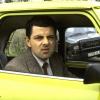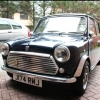You must have two distinct faults, which is not uncommon. If no lights at all (head, side or tail) are working, the fault is in the brown feed to the light switch, the light switch itself, or both front and rear (black) earths have failed. There are no other places where a fault would kill all the lights. If the car is running, but there are no indicators or brake lights, the fault is in the green circuit, which comes from the ignition switch controlled white circuit via a fuse, so by following wire colours you can see which fuse is involved. But, a double earth fault, front and rear, will also kill all indicators and brake lights. So it is both the brown feed to the light switch, and the green circuit, or its fuse, or alternatively both front and rear earths that have failed.
Oh, but please tell us one thing, do the interior light, horn and headlight flasher work? If so, forget what I said about the front earths and concentrate on the browns and greens. I mention horn and interior light, as checks on the purple circuit, if they work and the headlights do not, go for the bullet connectors behind the grille.
I should explain that on all Minis (with some slight complications on newer ones) there are very few main circuits, which can be identified by wire colour, which is always the same. Brown is permanently live, or should be, and several of those branch out from the main battery terminal of the starter solenoid, but others may diverge using multiple terminals on the fusebox, white is ignition switch controlled, from brown, purple is auxiliaries that are needed at any time, even when ignition is off, blue is headlights from light switch to dip switch, red is lights from light switch, probably becoming red-green via a fuse, green is fused auxiliaries, live only with ignition on, fused from white, light green with a stripe is from the accessory position (first click onwards) of the ignition switch, but light green-brown is also used in the "flash" circuit, the flasher unit being fed from the green, and the main colour is dominant in every subsidiary circuit, so indicators become green-red and green-white, main beam headlights blue-white, dip blue-red, brake lights green-pink (fed from green via the pedal or hydraulic switch) etc.
I suggest that you should get hold of, or make, a test lamp, because people here could easily guide you through some simple, logical tests instead of spending uppteen quid an hour at a garage, who may well spend many hours on this. A test lamp is only a socket containing a small 12V bulb, say 5 watt (sidelight etc), with two wires, one usually ending in a croc clip so you can connect it to earth, and the other ending in an insulated pointed probe, so you can prod things to see if they are live. The lampholder from the alternator warning position on a Mini or similar car is insulated from earth on both wires, and can make a useful basis for a test lamp.
A multimeter is better, but first things first. With a test lamp, and following a logical sequence, locating this fault should actually be quite simple.
But for now, as you have checked around the fusebox, I suggest also checking the several brown wires that attach to the battery terminal of the starter solenoid, the front earths (bunch of black wires that join at bullet connectors behind the grille and run back to an earth point, usually on the right bulkhead gusset), and the rear earths (again, bunch of black wires, join at bullet connectors near the fuel tank, with an earth connection somewhere in that area). Also check that the brown wire has not simply pulled off the back of the light switch. You are not looking for faults anywhere else, unless of course all the bulbs have failed, but I expect you have changed them already.
You can accomplish a great deal yourself without particular electrical knowledge, just by reporting accurately here what is wrong (i.e. EXACTLY what does not work, having checked everything, which you seem to have done already) and carrying out any simple checks that you are recommended to do, again EXACTLY as said. The trouble that comes here from electrical problems is that sometimes we get a partial description, a vague description that lights don't work, for instance, without saying which, and so far you have done well as regards describing the symptoms. We also get problems from people that are over-eager to please, saying "check the fuse", but fortunately in this case only part of the problem, the indicators and brake lights, and maybe the headlight flashers, may involve a fuse, so I think there is a good chance of getting this sorted out without the garage.
One thing to look for is that the wires can corrode just inside the crimp terminals, and may look ok on casual examination, but are actually not making contact.
![]()
![]()

















